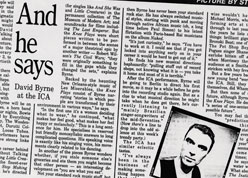ORIGINAL
PRESS CLIPPINGS

A ROBERT WILSON PROMER:
THE ENIGMATIC AUTHOR AND HIS "KNEE PLAYS"
Yet Wilson's career is over the two-decade mark, and recognition of his extraordinary gifts came early and steadily from many quarters. The New Yorker ran a profile of Wilson (by Calvin Tomkins) in 1975, hailing his innovative achievements. In the late '60s, he drew the interest of Jerome Robbins (who at the time was running an experimental American Theatre Laboratory). Robbins afterwards created a mysterious, highly symbolic ballet, "Watermill," for the New York City Ballet, which would have been unthinkable without the contagion of Wilson's ideas. In 1976, two performances of "Einstein" at the Metropolitan Opera were instant sellouts. Not many Washingtonians, save for a handful of Wilson fanatics, are aware that at least five Wilson creations of various sizes and kinds have been mounted in this city since 1974, in places that include the Kennedy Center and the Corcoran Gallery.
With the very successful revival of "Einstein" at the Brooklyn Academy two years ago, Wilson's domestic fortunes seem to have taken a decided turn upwards. Not without simultaneous reverses among the gains, however — "the Knee Plays" premiered in Minneapolis earlier in 1984, but the grand vision of producing the complete "the CIVIL warS" as the opening attraction of Los Angeles' Olympic Arts Festival that year was torpedoed by insufficient funding. The following year, the Brooklyn Academy mounted Wilson's "The Golden Windows" (Peter Sellars had wanted to bring it to the Kennedy Center afterwards but couldn't manage it).
Early this year, another complete production of "the CIVIL warS" announced for Austin, Tex., was canceled, again because of money. Since then, however, the American Repertory Theatre in Cambridge — where, at the initiative of director Robert Brustein, the Cologne section of "the CIVIL warS" had its U.S. premiere in 1985, and the current tour of "the Knee Plays" began — has produced his "Alcestis" and announced further stagings to come; the New York University theater department came up with a memorable account of "Hamletmachine," a Wilson collaboration with East German playwright Heiner Muller; and public television has aired a fascinating, hour-long documentary on Wilson and the revival of "Einstein" (this last may well have brought Wilson into contact with a broader slice of the American public than ever before).
When Wilson works on a large canvas, he also tackles mammoth subject matter. Earlier Wilson productions focused on such cultural icons as Sigmund Freud, Joseph Stalin, Queen Victoria and Thomas Edison. "Einstein on the Beach" dealt with the mind-boggling contraries implicit in Einstein and his legacy — on the one hand, evolutionary new understandings of the universe, an impulse toward pacifism and love of music; and on the other, the prospect of nuclear holocaust.